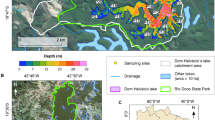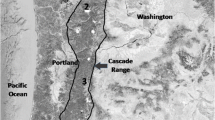Abstract
Lake surveys conducted in 1987–88 and 2018–19 show changes in the chemical and optical properties of Adirondack lakes recovering from acidification. Among chronically acidified lakes (1980s pH < 5.5, ANC < 0 µeq L−1), increases in pH and reductions in monomeric Al were accompanied by significant increases in light attenuation, DOC, and CDOM. DOC-specific dissolved color (CDOM:DOC) doubled over the 30-year span, and is the likely factor accounting for loss of water clarity in Adirondack lakes during recovery from acidification. Monitoring data (1994–2002) from a subset of these lakes show that reductions in light attenuation were accompanied by stronger thermal stratification and greater hypolimnetic oxygen depletion. Lakes most affected by acidification experienced greater loss of water clarity during recovery relative to moderately acidified lakes. These findings are consistent with the hypothesis that lake acidification resulted in a reduction in light attenuation by CDOM resulting in greater water clarity in acidified lakes, and that this process has been reversed following regional declines in sulfate deposition.




Similar content being viewed by others
References
Almer B, Dickson W, Ekstrom C, Hornstrom E, Miller U (1974) Effects of acidification on Swedish lakes. Ambio 3:30–36
Beier CM, Stella JC, Dovciak M, McNulty SA (2012) Local climatic drivers of changes in phenology at a boreal-temperate ecotone in eastern North America. Climactic Change 115:399–417
Bertilsson S, Tranvik LJ (2000) Photochemical transformation of dissolved organic matter in lakes. Limnol Oceanogr 45:753–762
Blomqvist P, Bell RT, Olofsson H, Stensdotter U, Vrede K (1995) Plankton and water chemistry in Lake Njupfatet before and after liming. Can J Fish Aquat Sci 52:551–565
Bricaud A, Morel A, Prieur L (1981) Absorption by dissolved organic matter of the sea (yellow substance) in the UV and visible domains. Limnological Oceanography 26:43–53
Bukaveckas PA (1988) Effects of calcite treatment on primary producers in acidified Adirondack lakes. I. Response of macrophyte communities. Lake Reservoir Manage 4:107–113
Bukaveckas PA (1993) Changes in primary productivity associated with liming and reacidification of an Adirondack lake. Environ Pollut 79:127–133
Bukaveckas PA, Driscoll CT (1991) Effects of whole-lake base addition on the optical properties of three clearwater acidic lakes. Can J Fish Aquat Sci 48:1030–1040
Bukaveckas PA, Robbins-Forbes M (2000) The role of dissolved organic carbon in the attenuation of photosynthetically active and ultraviolet radiation in Adirondack lakes. Freshw Biol 43:339–354
Davies-Colley RJ, Vant WN (1987) Absorption of light by yellow substance in freshwater lakes. Limnol Oceanogr 32:416–425
Driscoll CT, Newton RM (1985) Chemical characteristics of Adirondack lakes. Environ Sci Technol 19:1018–1024
Driscoll CT, Newton RM, Gubala CP, Baker JP, Christensen SW (1991) Adirondack Mountains. p. 133–202. In [ed.], D. F. Charles Acidic Deposition and Aquatic Ecosystems: Regional Case Studies. Springer-Verlag.
Driscoll CT, Driscoll KM, Fakhraei H, Civerolo K (2016) Long-term temporal trends and spatial patterns in the acid-base chemistry of lakes in the Adirondack region of New York in response to decreases in acidic deposition. Atmos Environ 146:5–14
Effler SW, Schafran GC, Driscoll CT (1985) Partitioning light attenuation in an acidic lake. Can J Fish Aquat Sci 42:1707–1711
Fee EJ, Hecky RE, Kasian SEM, Cruikshank DR (1996) Effects of lake size, water clarity and climatic variability on mixing depths in Canadian Shield lakes. Limnol Oceanogr 41:912–920
Field SD, Effler SW (1983) Light attenuation in Onandaga Lake, NY, USA. Arch Hydrobiol 98:409–421
Frost TM, Montz PK, Kratz TK, Badillo T, Brezonik PL, Gonzalez MJ, Rada RG, Watras CJ, Webster KE, Wiener JG, Williamson CE, Morris DP (1999) Multiple stresses from a single agent: diverse responses to the experimental acidification of Little Rock Lake, Wisconsin. Limnol Oceanogr 44:784–794
Garmo OA et al (2014) Trends in surface water chemistry in acidified areas in Europe and North America from 1990 to 2008. Water Air Soil Pollut 225:1880
Gavin AL, Nelson SJ, Klemmer AJ, Fernandez IJ, Strock KE, McDowell WH (2018) Acidification and climate linkages to increased dissolved organic carbon in high elevation lakes. Water Resour Res 54:5376–5393
Gibbs JP, Halstead JM, Boyle KJ, Huang J-C (2002) An hedonic analysis of the effects of lake water clarity on New Hampshire lakefront properties. Agric Resource Econ Rev 31:39–46
Goldstein RA, Chen CW, Gherini SA (1985) Integrated lake-watershed acidification study: summary. Water Air Soil Pollut 26:327–337
Grahn O, Hultberg H, Landner L (1974) Oligotrophication—a self-accelerating process in lakes subjected to excessive supply of acid substance. Ambio 3:93–94
Hargeby A, Blindow I, Andersson G (2007) Long-term patterns of shifts between clear and turbid states in Lake Krankesjon and Lake Takern. Ecosystems 10:29–36
Hornstrom E, Ekstrom C, Froberg E, Ek J (1993) Plankton and chemical-physical development in six Swedish west coast lakes under acidic and limed conditions. Can J Fish Aquat Sci 50:688–702
Keller W, Heneberry J, Leduc J, Gunn J, Yan ND (2006) Variations in epilimnion thickness in small boreal shield lakes: relationships with transparency, weather and acidification. Environ Monit Assess 115:419–431
Kirk JTO (1994) Light and Photosynthesis in Aquatic Ecosystems, 2nd edn. Cambridge University Press, New York, NY
Kopacek J, Hejzlar J, Kana J, Norton SA, Stuchlik E (2015) Effects of acidic deposition on in-lake phosphorus availability: a lesson from lakes recovering from acidification. Environ Sci Technol 49:2895–2903
Kopacek J, Kana J, Bicarova S, Brahney J, Navratil T, Norton SA, Porcal P, Stuchlik E (2019) Climate change accelerates recovery of the Tatra Mountain lakes from acidification and increases their nutrient and chlorophyll a concentrations. Aquat Sci 81:70
Kretser WJ, Gallagher J, Nicolette J (1989) An Evaluation of Fish Communities and Water Chemistry. Adirondack Lakes Survey Corporation, Ray Brook
Leach TH et al (2017) Patterns and drivers of deep chlorophyll maxima structure in 100 lakes: the relative importance of light and thermal stratification. Limnol Oceanogr 63:628–646
Leach TH et al (2018) Long-term dataset on aquatic responses to concurrent climate change and recovery from acidification. Scientific Data 5:180059
Leach TH, Winslow LA, Hayes NM, Rose KC (2019) Decoupled trophic responses to long-term recovery from acidification and browning in lakes. Glob Change Biol 25:1779–1792
Lottig NR, Wagner T, Henry EN, Cheruvelil KS, Webster KE, Downing JA, Stow CA (2014) Long-term citizen-collected data reveal geographical patterns and temporal trends in water clarity. PLoS ONE 9:e95769
Meyer-Jacob C, Labaj AL, Paterson AM, Edwards BA, Keller W, Cumming BF, Smol JP (2020) Re-browning of Sudbury (Ontario, Canada) lakes now approaches pre-acid deposition lake-water dissolved organic carbon levels. Sci Total Environ 725:138347
Momen B, Lawrence GB, Nierzwicki-Bauer SA, Sutherland JW, Eichler LW, Harrison JP, Boylen CW (2006) Trends in summer chemistry linked to productivity in lakes recovering from acid deposition in the Adirondack region of New York. Ecosystems 9:1306–1317
Monteith DT et al (2007) Dissolved organic carbon trends resulting from changes in atmospheric deposition chemistry. Nature 450:537–541
Morton R, Henderson BL (2008) Estimation of non-linear trends in water quality: an improved approach using generalized additive models. Water Resour Res 44:W07420
Murphy RR, Perry E, Harcum J, Keisman J (2019) A Generalized Additive Model approach to evaluating water quality: chesapeake Bay case study. Environ Model Softw 118:1–13
Nierzwicki-Bauer SA, Boylen CW, Eichler LW, Harrison JP, Sutherland JW, Shaw W, Daniels RA, Charles DF, Acker F, Sullivan TJ, Momen B, Bukaveckas PA (2010) Acidification in the Adirondacks: Defining the biota in trophic levels of 30 chemically diverse acid-impacted lakes. Environ Sci Technol 44:5721–5727
Pace ML, Reche I, Cole JJ, Fernandez-Barbero A, Mazuecos IP, Prairie YT (2012) pH change induces shifts in the size and light absorption of dissolved organic matter. Biogeochemistry 108:109–118
Richards R, Hughes L, Gee D, Tomlinson R (2013) Using generalized additive models for water quality assessments: a case study example from Australia. J Coastal Res 65:111–116
Richardson DC et al (2017) Transparency, geomorphology and mixing regime explain variability in trends in lake temperature and stratification across northeastern North America (1975–2014). Water 9:442
Roulet NT, Moore TR (2006) Browning the waters. Nature 444:283–284
Sahoo GB, Schladow SG, Reuter JE (2010) Effects of sediment and nutrient loading on Lake Tahoe optical conditions and restoration opportunities using a newly developed lake clarity model. Water Resour Res 46:W10505
Scheffer M, Hosper SH, Meijer M-L, Moss B, Jeppesen E (1993) Alternative equilibria in shallow lakes. Trends Ecol Evol 8:275–279
Schofield, C.L. (1972) The ecological significance of air pollution induced changes in water quality and dilute lake districts in the Northeast. Trans. N. E. Fish Wildl. Conf. pp. 98–112.
Seekell DA, Lapierre J-F, Ask J, Bergstrom A-K, Deininger A, Rodriguez P, Karlsson J (2015) The influence of dissolved organic carbon on primary production in northern lakes. Limnol Oceanogr 60:1276–1285
Shearer JA, Fee EJ, DeBruyn ER, DeClercq DR (1987) Phytoplankton production and light attenuation responses to the experimental acidification of a small Canadian shield lake. Can J Fish Aquat Sci 44:83–90
Singer R, Roberts DA, Boylen CW (1983) The macrophyte community of an acidic lake in Adirondack (New York, USA): a new depth record for aquatic angiosperms. Aquat Bot 16:49–57
Solomon CT, Jones SE, Weidel BC, Buffam I, Fork ML, Karlsson J, Larsen S, Lennon JT, Read JS, Sadro S, Saros JE (2015) Ecosystem consequences of changing inputs of terrestrial dissolved organic matter to lakes: current knowledge and future challenges. Ecosystems 18:376–389
Sondergaard M, Phillips G, Hellsten S, Kolada A, Ecke F, Maemets H, Mjelde M, Azella MM, Oggioni A (2013) Maximum growing depth of submerged macrophytes in European lakes. Hydrobiologia 704:165–177
Staehr PA, Bade DL, Van de Bogert MC, Koch GR, Williamson CE, Hanson PC, Cole JJ, Kratz TK (2010) Lake metabolism and the diel oxygen technique: state of the science. Limnol Oceanogr Methods 8:628–644
Strock KE, Nelson SJ, Kahl JS, Saros JE, McDowell WH (2014) Decadal trends reveal recent acceleration in the rate of recovery from acidification in the northeaster US. Environ Sci Technol 48:4681–4689
Strock KE, Theodore N, Gawley WG, Ellsworth AC, Saros JE (2017) Increasing dissolved organic carbon concentrations in northern boreal lakes: implications for lake water transparency and thermal structure. J Geophys Res Biogeosci 122:1022–1035
Vasconcelos FR, Diehl S, Rodriguez P, Karlsson J, Bystrom P (2018) Effects of terrestrial organic matter on aquatic primary production as mediated by pelagic-benthic resource fluxes. Ecosystems 21:1255–1268
Wasswa J, Driscoll CT, Zeng T (2020) Photochemical characterization of surface waters from lakes in the Adirondack region of New York. Environ Sci Technol 54:10654–10667
Williamson CE, Overholt EP, Pilla RM, Leach TH, Brentrup JA, Knoll LB, Mette EM, Moeller RE (2015) Ecological consequences of long-term browning in lakes. Sci Rep 5:18666
Wood S (2006) Generalized Additive Models: an Introduction with R, 1st edn. Chapman and Hall/CRC, Boca Raton
Yang G, Moyer DL (2020) Estimation of non-linear water quality trends in high-frequency monitoring data. Sci Total Environ 715:136686
Yuan LL (2021) Continental-scale effects of phytoplankton and non-phytoplankton turbidity on macrophyte occurrence in shallow lakes. Aquat Sci 83:14
Acknowledgements
I am grateful to Rachel Henderson for her assistance with the GAM analysis. I thank those who facilitated lake access: Camp Gorham YMCA, Stacy McNulty (SUNY ESF Huntington Forest), Beth Pashley, Cliff and Ellie Reed Lewis, and David Smith (NYS DEC). I am also indebted to colleagues at the Rensselaer Polytechnic Institute who collected and shared the AEAP data. This paper is dedicated to Donald R. Whitehead, a friend and mentor who encouraged my work on Adirondack lakes. Don’s research in paleolimnology advanced our understanding of post-glacial forest history; his summer field courses introduced students to the beauty and wonder of the Adirondacks.
Author information
Authors and Affiliations
Corresponding author
Ethics declarations
Conflict of interest
The author declares no known competing financial interests or personal relationships that influenced the work reported in this paper.
Additional information
Publisher's Note
Springer Nature remains neutral with regard to jurisdictional claims in published maps and institutional affiliations.
Rights and permissions
About this article
Cite this article
Bukaveckas, P.A. Changes in acidity, DOC, and water clarity of Adirondack lakes over a 30-year span. Aquat Sci 83, 50 (2021). https://doi.org/10.1007/s00027-021-00807-6
Received:
Accepted:
Published:
DOI: https://doi.org/10.1007/s00027-021-00807-6




